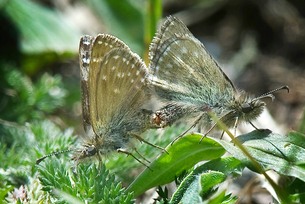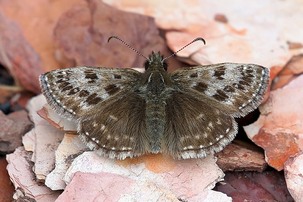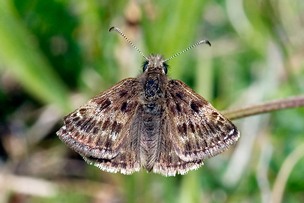

Biodiversity
Action
Plan
Dingy Skipper: an inconspicuous, well-camouflaged, small butterfly; with an extremely fast flight, it can be seen darting along close to the ground. It basks on bare ground with wings spread wide. In dull weather or at night it perches on the top of dead flowerheads in a moth-like fashion.
In Barnsley scattered colonies are known from Penistone eastwards.
The species is very local and largely, perhaps almost exclusively, dependent on land that has been previously developed.
Dingy Skipper, Erynnis tages
UKBAP priority species
S41 Species of Principal Importance.
Red List: Vulnerable. Increasingly rare
Butterfly Conservation: High Priority.
Protection
As a species of principal importance, the presence of Dingy Skipper needs to be taken into consideration with a view to conservation by any public body.
This includes avoiding sites with a colony for development and promoting their conservation and enhancement.
In Barnsley a site with a Dingy Skipper colony is of sufficient priority to be designated a Local Wildlife Site.
Local Wildlife Sites have a presumption against development but no protection against operations that do not require planning or change of use consent.
Dingy Skipper has no legal protection.
It is a sedentary species that is unlikely to colonise new areas of habitat unless they are close to existing population. The scattered occasional colonies in Barnsley are mainly found on waste ground, pit stacks, disused railway tracks and sparsely vegetated roadside verges.
Common Bird’s-foot Trefoil is the usual larval foodplant and Greater Bird’s-foot Trefoil on heavier soils. The adult prefers to nectar on yellow flowers with a preference for Bird's-foot Trefoil, Buttercups, Hawkweeds and Vetches.
A freshly-emerged Dingy Skipper has a subtle attractive pattern of browns and greys. However overtime scales are lost to give a drab appearance.
It is a warmth-loving species preferring open sunny areas and spends long periods basking on bare earth or stones.
There is one generation a year, with adults usually flying from early May until the end of June. In hot summers there may be a partial second brood in August at some sites. Eggs are laid singly on young leaves of the foodplant. The larvae overwinter on the foodplant.
Conservation: Maintain a sparse sward with patches of bare ground, sufficient Bird’s-foot Trefoil as the foodplant, and flowering plants for nectar. Some areas of taller vegetation should be maintained.
Suitable habitat conditions occur where the larval food-plant grows in a sparse sward with patches of bare ground. Taller vegetation is required for shelter and roosting.

For more information:
UK Butterflies: Dingy Skipper
Butterfly Conservation: Dingy Skipper
Local Priority Habitats:
Open Mosaic on Previously Developed Land; Built Environment, brownfield sites, Verges; Lowland Heath.
Potentially Mixed Deciduous Woodland.
Dingy Skipper butterfly

